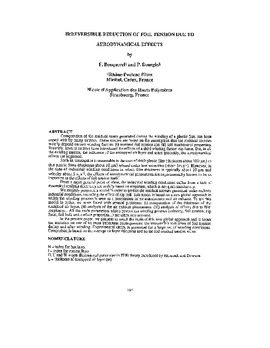| dc.contributor.author | Bouquerel, F. | |
| dc.contributor.author | Bourgin, P. | |
| dc.contributor.other | International Conference on Web Handling (1993) | |
| dc.date.accessioned | 2019-11-04T19:56:16Z | |
| dc.date.available | 2019-11-04T19:56:16Z | |
| dc.date.issued | 1993-06 | |
| dc.identifier | oksd_icwh_1993_bouquerel | |
| dc.identifier.citation | Bouquerel, F., & Bourgin, P. (1993, June). Irreversible reduction of foil tension due to aerodynamical effects. Paper presented at the Second International Conference on Web Handling (IWEB), Stillwater, OK. | |
| dc.identifier.uri | https://hdl.handle.net/11244/321672 | |
| dc.description.abstract | Computation of the residual stress generated during the winding of a plastic film has been coped with by many authors. These studies are based on the assumption that the residual stresses mainly depend on two winding factors: (i) nominal foil tension and (ii) foil mechanical properties. Recently, several authors have introduced the effects of a third winding factor: nip force. But, in all the existing studies, the influence of the entrapped air layer and more generally, the aerodynamical effects are neglected. | |
| dc.description.abstract | Such an assumption is reasonable in the case of thick plastic film (thickness about 100 μm) or thin plastic films (thickness about 10 μm) wound under low velocities (about 1 m.s-1). However, in the case of industrial winding conditions in which film thickness is typically about 10 μm and velocity about 5 m.s-1, the effects of aerodynamical phenomena are experimentally known to be as important as the effects of foil tension itself. | |
| dc.description.abstract | From a more general point of view, the industrial winding conditions suffer from a lack of theoretical analysis since they are mainly based on empirism, which is not quite satisfactory. | |
| dc.description.abstract | We recently proposed a model in order to predict the residual stresses generated under realistic industrial conditions, including the effect of nip roll. This model is based on a new global approach in which the Winding process is seen as a mechanism of air entrainment and air exhaust To set this model in order, we were faced with several problems: (i) computation of the thickness of the entrained air layer, (ii) analysis of the air exhaust phenomena, (iii) analysis of effects due to film roughness ... All the main parameters which govern the winding process (velocity, foil tension, nip force, foil bulk and surface properties ... ) are taken into account. | |
| dc.description.abstract | In the present paper, we propose to recall the basis of this new global approach and to focus our attention on one of its most important consequences: the irreversible reduction of foil tension during and after winding. Experimental check is presented for a large set of winding conditions. Comparison is based on the average air layer thickness and on the foil residual tension value. | |
| dc.format | application/pdf | |
| dc.language | en_US | |
| dc.publisher | Oklahoma State University | |
| dc.rights | In the Oklahoma State University Library's institutional repository this paper is made available through the open access principles and the terms of agreement/consent between the author(s) and the publisher. The permission policy on the use, reproduction or distribution of the article falls under fair use for educational, scholarship, and research purposes. Contact Digital Resources and Discovery Services at lib-dls@okstate.edu or 405-744-9161 for further information. | |
| dc.title | Irreversible reduction of foil tension due to aerodynamical effects | |
| osu.filename | oksd_icwh_1993_bouquerel.pdf | |
| dc.type.genre | Conference proceedings | |
| dc.type.material | Text | |
